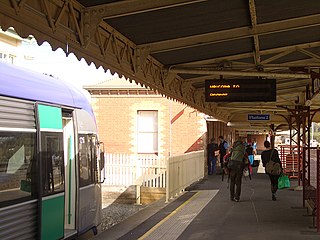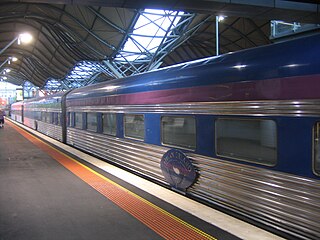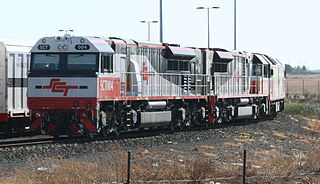
Rail transport in Australia is a crucial aspect of the Australian transport network. Rail in Australia is to a large extent state-based. As at 2018, the Australian rail network consisted of a total of 33,168 kilometres (20,610 mi) of track on three major track gauges.

Rail transport in Victoria, Australia, is provided by a number of railway operators who operate over the government-owned railway lines. The network consists of Victorian broad gauge lines, and an increasing number of standard gauge freight and interstate lines; the latter brought into existence as a result of gauge conversion of the former. Historically, a few experimental 762 mm gauge lines were built, along with various private logging, mining and industrial railways.

The Australian Rail Track Corporation (ARTC) is a Government of Australia owned statutory corporation, established in July 1998, that manages most of Australia's interstate rail network.

Freight Australia was an Australian railway company that purchased the V/Line Freight business from the Government of Victoria in 1999. Initially known as Freight Victoria, it operated rail freight services and controlled non-urban rail track in the state of Victoria, later expanding into freight haulage in other states. Freight Australia was sold to Pacific National in August 2004.

Ballarat railway station is located on the Serviceton line in Victoria, Australia. It serves the city of Ballarat opening on 11 April 1862.

Beaufort railway station is located on the Serviceton line, in Victoria, Australia. It serves the town of Beaufort, and opened on 11 August 1874, as the temporary terminus of the line from Ballarat. On 7 April 1875, the line was extended to Ararat. It was disestablished as a staff station on 14 September 1988, with the signal box abolished. The electric staff sections Trawalla - Beaufort and Beaufort - Buangor were also abolished, replaced with the electric staff section Trawalla - Buangor. The station closed on 27 May 1994, but reopened on 11 July 2004, when passenger services to Ararat resumed.

Ararat railway station is located on the Serviceton and Western standard gauge lines, in Victoria, Australia. It serves the town of Ararat, and opened on 7 April 1875. It is also the junction for the Ararat – Maryborough line.
The Mildura railway line is a heavy rail line in northwestern Victoria, Australia. The line runs from Yelta station to Ballarat station via the settlements of Mildura, Ouyen and Maryborough in an approximate south-southeasterly direction. Initial sections of the line opened from Ballarat in 1874 and the line reached Mildura in 1903.

The rail network of Melbourne, Australia, has an significant number of railway lines and yards serving freight traffic. Rail transport in Victoria is heavily focused on Melbourne, and, as a consequence, much of the state's rail freight passes through the metropolitan network.

The G Class are a class of diesel locomotive built by Clyde Engineering, Rosewater and Somerton for V/Line between 1984 and 1989.
The east–west rail corridor is a standard gauge railway that runs across Australia starting in Sydney, New South Wales, linking the Eastern states to Western Australia. The Indian Pacific passenger service operates along the route, as do a number of local passenger services.
The Melbourne–Adelaide rail corridor is a standard-gauge railway corridor that runs between the cities of Melbourne, Victoria and Adelaide, South Australia. Most of the current traffic is freight, though the only named and perhaps best known regular train is the twice-weekly passenger service The Overland, operated by Great Southern Rail.
The Geelong–Ballarat railway line is a broad-gauge railway in western Victoria, Australia between the cities of Geelong and Ballarat. Towns on the route include Bannockburn, Lethbridge, Meredith, Elaine and Lal Lal. Major traffic includes general freight from the Mildura line, and grain.
The Adelaide-Wolseley railway line is a 313 kilometre line running from Adelaide to Wolseley on the Australian Rail Track Corporation network. It is the South Australian section of the Melbourne–Adelaide railway.
In 1937, the South Australian Railways extended its broad gauge line north from Redhill to Port Pirie. In the same year, the Commonwealth Railways extended its standard gauge Trans-Australian Railway line from Port Augusta south to Port Pirie.




















